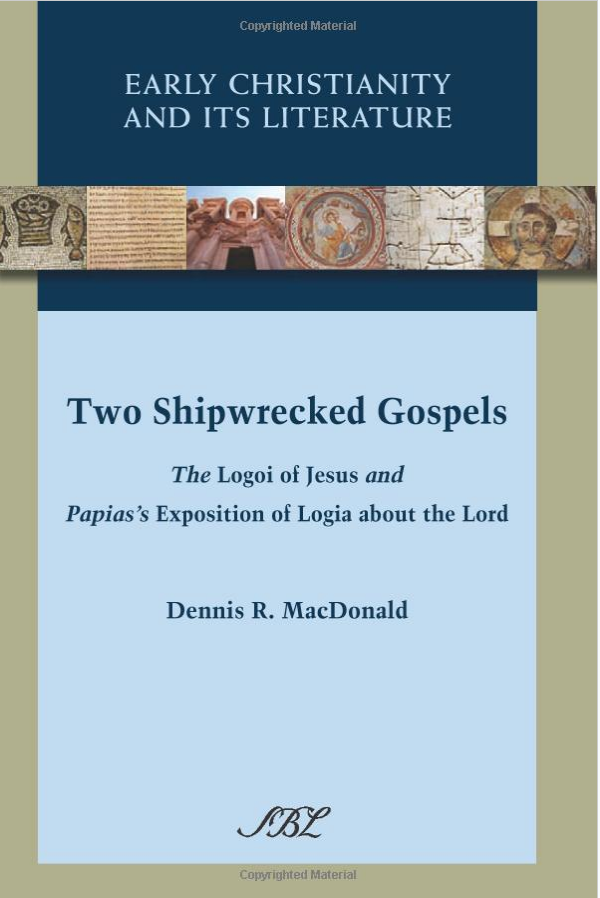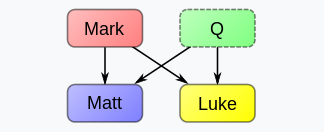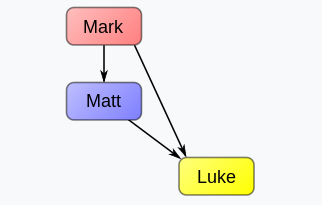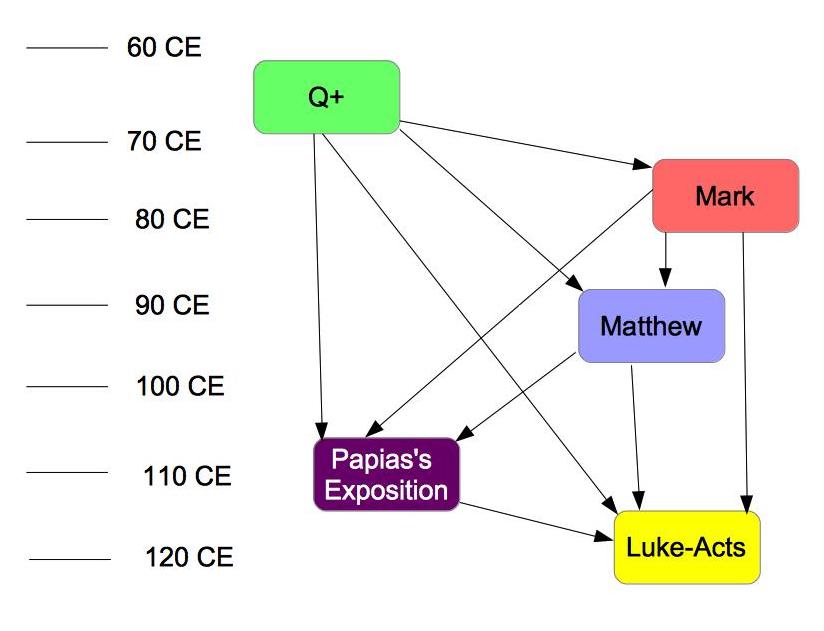 After five years of guilty looks at my unread copy of Dennis R. MacDonald’s Two Shipwrecked Gospels: The Logoi of Jesus and Papias’s Exposition of Logia about the Lord, I finally overcame my fear of reading its 700 pages of radically new argument addressing the “synoptic gospel problem” — and was very pleasantly surprised. I enjoyed it. It was not fearsomely complex at all. It was a positively challenging and thought provoking read. Speculative in places, yes, but speculation is always tethered to the rocks of data; it is not free-floating speculation. And much of the discussion is a close examination of composition and density of those data rocks with a view to testing the explanatory power of the thesis.
After five years of guilty looks at my unread copy of Dennis R. MacDonald’s Two Shipwrecked Gospels: The Logoi of Jesus and Papias’s Exposition of Logia about the Lord, I finally overcame my fear of reading its 700 pages of radically new argument addressing the “synoptic gospel problem” — and was very pleasantly surprised. I enjoyed it. It was not fearsomely complex at all. It was a positively challenging and thought provoking read. Speculative in places, yes, but speculation is always tethered to the rocks of data; it is not free-floating speculation. And much of the discussion is a close examination of composition and density of those data rocks with a view to testing the explanatory power of the thesis.
Before I outline MacDonald’s suggestions let’s refresh our memories of the most common prevailing views of the synoptic problem. The most common view is that the Gospels of Matthew and Luke independently drew upon the Gospel of Mark and another (mostly sayings) source now lost to us, Q:

Still a minority view, but one that appears to be gaining a little more ground since Mark Goodacre’s The Case Against Q is a revamping of the Farrer thesis:

You can see other proposed solutions to the question of the relationship between the synoptic gospels if you go to the wikipedia link I have added to each of the above models.
Enter Dennis MacDonald and his thesis that includes the writings of Papias. Papias? We know about him from what others like Eusebius and Irenaeus have said about him. You will remember that he was the early second century name associated with a rather bizarre story about Judas (he swelled up until he exploded) yet more soberly with discussions he held with certain elders and accounts of the gospels of Mark (it was a record of Peter’s memories but Mark got the order of events all mixed up) and Matthew (Matthew originally wrote his gospel in Hebrew but he got the order of events right).
Papias was said to have written The Expositions of the Logia (sayings and stories) about the Lord in five books. With the benefit of other scholars’ research (especially Norelli’s) into the ancient references to these five books of Expositions MacDonald has attempted to reconstruct some idea of the contents of these respective five volumes.
In the following outline of MacDonald’s resulting suggested (he is far from dogmatic) “reconstruction” I have mostly incorporated extracts from Ben C. Smith’s Textexcavation site.
.
The Five Books of the Expositions of the Logia of the Lord
Book 1: Preface and John’s Preaching
This book introduced the title of the work (Expositions…) and the name of its author (Papias) and the name of the person to whom it was dedicated. Here also Papias discussed the gospels of Mark and Matthew and spoke about the elder John.
.
From Eusebius:
And the elder would say this: Mark, who had become the interpreter of Peter, wrote accurately, yet not in order, as many things as he remembered of the things either said or done by the Lord. For he neither heard the Lord nor followed him, but later, as I said, Peter, who would make the teachings to the needs, but not making them as an ordering together of the lordly oracles, so that Mark did not sin having thus written certain things as he remembered them. For he made one provision, to leave out nothing of the things that he heard or falsify anything in them. . . . . .
These things therefore are recorded by Papias about Mark. But about Matthew he says these:
Matthew therefore in the Hebrew dialect ordered together the oracles, and each one interpreted them as he was able. . . . .
[Papias himself writes:] But I shall not hesitate to arrange alongside my interpretations as many things as I ever learned well and remembered well from the elders, confirming the truth on their behalf. For I did not rejoice, like many, over those who spoke many things, but [rather] over those who taught the truth, nor over those who related strange commands, but over those who related those given by the Lord by faith and coming from the truth itself.
[Papias continues:] And if anyone chanced to come along who had followed the elders, I inquired as to the words of the elders, what Andrew or what Peter had said, or what Philip or what Thomas or James or what John or Matthew or any other of the disciples of the Lord [had said], the things which both Aristion and the elder John, disciples of the Lord, were saying. For I did not suppose that things from books would profit me as much as things from a living and remaining voice.
.
From John of Scythopolis:
They would call children those who practiced no evil according to God, as Papias makes clear in the first book of the EXEGESES of the Lord, along with Clement the Alexandrian in the PEDAGOGUE.
Compare Matthew 3:8-10 where God’s children are the righteous:
8 Produce fruit in keeping with repentance. 9 And do not think you can say to yourselves, ‘We have Abraham as our father.’ I tell you that out of these stones God can raise up children for Abraham. 10 The ax is already at the root of the trees, and every tree that does not produce good fruit will be cut down and thrown into the fire.
.
Book 2: Jesus in Galilee and Judea
Having less to work with at this point MacDonald writes: “Book 2 apparently contained interpretations of Jesus’ career in Galilee and Judea, approximately equivalent to Matt 4:12-20:34. . . . It is possible that Eusebius found in book 2 what he describes as “other content as though they came to him from an unwritten tradition, as well as some of the savior’s strange parables, his teachings, and some other things even more fictional” (Expos. 3:1). Only Norelli frg. 10, from Philip of Side, can be placed here with confidence . . . ” (p. 18)
.
From Eusebius:
and set out also another record about a woman who was charged for many sins before the Lord, which the gospel according to the Hebrews has.
(Today this passage is found in John 8:3-11 where many scholars deem it to be an interpolation; there is evidence that it was a “free-floating” tradition before it found its way into the Gospel of John.)
.
From Anastasius of Sinai:
Taking occasion from Papias of Hierapolis . . . . who understood the work of the six days as referring to Christ and the whole Church.
Compare Matthew 19:28 where we find the same thought: the future of the church was a restoration (regeneration, renewal) of God’s creation before the fall of Adam and Eve.
28 Jesus said to them, “Truly I tell you, at the renewal of all things, when the Son of Man sits on his glorious throne, you who have followed me will also sit on twelve thrones, judging the twelve tribes of Israel.
.
From Philip of Side:
Papias in the second volume says that John the theologian and James his brother were done away with by Jews.
Compare Matthew 20:20-23.
20 Then the mother of Zebedee’s sons came to Jesus with her sons and, kneeling down, asked a favor of him.
21 “What is it you want?” he asked.
She said, “Grant that one of these two sons of mine may sit at your right and the other at your left in your kingdom.”
22 “You don’t know what you are asking,” Jesus said to them. “Can you drink the cup I am going to drink?”
“We can,” they answered.
23 Jesus said to them, “You will indeed drink from my cup, but to sit at my right or left is not for me to grant. These places belong to those for whom they have been prepared by my Father.”
.
Book 3: Jesus in Jerusalem
Given Papias’s “obsession with chronological order and preference for Matthew’s arrangement” MacDonald suggests in Book 3 Papias was commenting on Matthew 21:1-25:46.
.
From Eusebius:
Papias reproduces other stories communicated to him by word of mouth, together with some otherwise unknown parables and teachings of the Saviour, and other things of a more allegorical character. He says that after the resurrection of the dead there will be a period of a thousand years, when Christ’s kingdom will be set up on this earth in material form. I suppose he got these notions by misinterpreting the apostolic accounts and failing to grasp what they had said in mystic and symbolic language.
Eusebius (1975). The history of the church from Christ to Constantine. (G. A. (Geoffrey A. Williamson, Trans.). Minneapolis, Minn. : Augsburg Pub. House. Retrieved from http://archive.org/details/historyofchurchf00euse (pp. 151-152)
Compare Matthew 25:31-36
31 “When the Son of Man comes in his glory, and all the angels with him, he will sit on his glorious throne. 32 All the nations will be gathered before him, and he will separate the people one from another as a shepherd separates the sheep from the goats. 33 He will put the sheep on his right and the goats on his left.
34 “Then the King will say to those on his right, ‘Come, you who are blessed by my Father; take your inheritance, the kingdom prepared for you since the creation of the world. 35 For I was hungry and you gave me something to eat, I was thirsty and you gave me something to drink, I was a stranger and you invited me in, 36 I needed clothes and you clothed me, I was sick and you looked after me, I was in prison and you came to visit me.’
.
Book 4: Jesus’ Death and Resurrection
Papias’s references to the Last Supper and Judas’s death are explicitly said to be in book 4 of his Expositions. It follows, MacDonald says, that book 4 corresponded to Matthew 26:1-28:20.
.
From Irenaeus:
The blessing thus predicted pertains, without [fear of] contradiction, to the times of the kingdom, when the just, rising from the dead, will reign, when even the creation, renewed and liberated, will produce a multitude of foods of all kinds from the dew of heaven and the fertility of the earth, just as the elders who saw John the disciple of the Lord remembered that they had heard from him how the Lord would teach about those times and would say:
The days will come in which vines will grow, each having ten thousand shoots, and on each shoot ten thousand branches, and on each branch ten thousand twigs, and on each twig ten thousand clusters, and in each cluster ten thousand grapes, and each grape, when pressed, will give twenty-five measures of wine. And, when one of those saints takes hold of a cluster, another cluster will clamor: I am better, take me, bless the Lord through me! Similarly a grain of wheat also will generate ten thousand heads, and each head will have ten thousand grains, and each grain five double pounds of clear and clean flour. And the remaining fruits and seeds and herbiage will follow through in congruence with these, and all the animals using these foods which are taken from the earth will in turn become peaceful and consenting, subject to men with every subjection.
Compare Matthew 26:29
I tell you, I will not drink from this fruit of the vine from now on until that day when I drink it new with you in my Father’s kingdom.
.
From Apollinarius of Laodicea:
Judas did not die by hanging, but lived on, having been cut down before choking. And this the ACTS OF THE APOSTLES makes clear, that falling headlong his middle burst and his bowels poured forth. And Papias the disciple of John records this most clearly, saying thus in the fourth of the EXEGESES OF THE WORDS OF THE LORD:
Judas walked about as an example of godlessness in this world, having been bloated so much in the flesh that he could not go through where a chariot goes easily, indeed not even his swollen head by itself. For the lids of his eyes, they say, were so puffed up that he could not see the light, and his own eyes could not be seen, not even by a physician with optics, such depth had they from the outer apparent surface. And his genitalia appeared more disgusting and greater than all formlessness, and he bore through them from his whole body flowing pus and worms, and to his shame these things alone were forced [out]. And after many tortures and torments, they say, when he had come to his end in his own place, from the place became deserted and uninhabited until now from the stench, but not even to this day can anyone go by that place unless they pinch their nostrils withtheir hands, so great did the outflow from his body spread out upon the earth.
Compare Matthew 27:3-10
3 When Judas, who had betrayed him, saw that Jesus was condemned, he was seized with remorse and returned the thirty pieces of silver to the chief priests and the elders. 4 “I have sinned,” he said, “for I have betrayed innocent blood.”
“What is that to us?” they replied. “That’s your responsibility.”
5 So Judas threw the money into the temple and left. Then he went away and hanged himself.
6 The chief priests picked up the coins and said, “It is against the law to put this into the treasury, since it is blood money.” 7 So they decided to use the money to buy the potter’s field as a burial place for foreigners. 8 That is why it has been called the Field of Blood to this day. 9 Then what was spoken by Jeremiah the prophet was fulfilled: “They took the thirty pieces of silver, the price set on him by the people of Israel, 10 and they used them to buy the potter’s field, as the Lord commanded me.”
.
From Andrew of Caesarea:
And Papias has thus, word for word: But to some of them, clearly those that were once divine, he both gave to rule over the cosmic arrangement around the earth and enjoined to rule well. And he says in the following: It turns out that their order ended up as nothing. And the great dragon, the ancient serpent who is called the devil and Satan, was cast out. The one who deceives the whole inhabited earth was cast down to the earth, along with his angels.
Compare Matthew 28:18
18 Then Jesus came to them and said, “All authority in heaven and on earth has been given to me.
.
Book 5: Events After Jesus’ Resurrection
Here we have accounts of the daughters of Philip, Justus Barsabas and the raising of Manaemus’s mother.
.
From Eusebius:
But it is fitting to the words of Papias already given to add other passages of his through which he recounts certain paradoxes and other things as having come to him from tradition.
That Philip the apostle lived in Heirapolis together with his daughters has been made clear before. But as regards them let it be noted that Papias, their contemporary, mentions a wondrous account that he received from the daughters of Philip. For he recounts a
resurrection from the dead in his time, and yet another paradox about Justus who was surnamed Barsabbas, as having drunk a deadly poison and yet, through the grace of the Lord, suffered no harm.And that this Justus, after the taking up of the savior, the holy apostles stood up with Matthias and prayed for the filling up of their number instead of the traitor Judas, in his slot, the writing of the ACTS records thus: And they stood up two, Joseph who is called Barsabbas, surnamed Justus, and Matthias. And they prayed and said….
.
From Philip of Side:
The aforesaid Papias reported as having received it from the daughters of Philip that Barsabas who is Justus, tested by the unbelievers, drank the venom of a viper inthe name of the Christ and was protected unharmed. He also reports other wonders andespecially that about the mother of Manaemus, her resurrection from the dead. Concerningthose resurrected by Christ from the dead, that they lived until Hadrian.
.
The Q+/Papias Hypothesis
So what does all of that have to do with the synoptic problem? That is really another question the answer to which covers analysis spanning several hundred pages of Two Shipwrecked Gospels. It also includes a Q that is more detailed than the quite short current Q consisting almost entirely of sayings of Jesus as Q is generally understood. So Dennis MacDonald calls his model the Q+/Papias hypothesis. It looks like this:
 Some readers may be confused by the link between Q+ and the Gospel of Mark. MacDonald is with those scholars who think Mark knew of Q even if he did not copy it as closely as did Matthew and Luke.
Some readers may be confused by the link between Q+ and the Gospel of Mark. MacDonald is with those scholars who think Mark knew of Q even if he did not copy it as closely as did Matthew and Luke.
MacDonald, D. R. (2012). Two Shipwrecked Gospels: The Logoi of Jesus and Papias’s Exposition of Logia About the Lord. Atlanta: Society of Biblical Literature.
If you enjoyed this post, please consider donating to Vridar. Thanks!

It sounds similar to Earl Doherty’s distinction between then Jerusalem tradition (Paul) and the Galilean tradition (Q). Mark will then appear as a first harmonization of the traditions.
Both Doherty annd McDonald are probably a lot more complicated than this, and I could not really understand it as I do not believe in any way in the authenticity of Paul’s letters or Markan priority, let alone a pre-Hadrianic (or even pre-Antonian) dating of any synoptic gospel whatsoever.
The five books of sayings may be interesting because the Gospel according to Saint Matthew consists of five blocks of sayings – with lots of action before, after, and specifically inbetween.
This was on reddit today:
https://imgur.com/TFik8MM
https://www.reddit.com/r/AcademicBiblical/comments/8dq41q/me_trying_to_explain_dennis_macdonalds_solution/
OK, the link was necessary to show the large difference to Doherty. Instead of a division inro rural Jewish vs. hellenized Jewish traditions, McDonald divides the influences of the Gospel according to Saint Mark into the Jewish tradition, filtered in Q+, vs. the classic Greek and Roman epos (Vegil and Homer). The gospel becomes thus an acute Judaization of the classic epos.
My view is that “Q” is Hebrew Matthew, which may have been just a collection of speeches from how some Ancients describe it.
It would pay to look at different ways recent authors have looked at (or are looking at) The Synoptic Problem.
eg. Matthias Klinghardt – “”The most obvious consequence of the priority of the Marcionite Gospel over Luke relates to the Synoptic Problem: when taking this ‘pre-Lukan gospel’ into account, the model of the inter-gospel relations changes profoundly. Most remarkably, this model disposes of the need for ‘Q’; the Two-Source Theory becomes entirely redundant; and the other models in discussion – such as the Farrer-Goulder-Goodacre hypothesis or the Neo-Griesbach Theory – are irrelevant. (320)”
Klinghardt suggests that the Marcionite Gospel is first, on which Mark depended. Matthew used both Mark and the Marcionite Gospel. John used the previous three, and Luke used all the previous four.
Klinghardt, M (2017) Marcion’s Gospel and the New Testament: Catalyst or Consequence? New Testament Studies 63(2); 318-323
Markus Vinzent thinks that Marcion himself actually wrote the earliest Gospel.
Jason BeDuhn thinks that the Two-Source hypothesis may be correct, once Luke is replaced in the equation with the Marcionite Gospel; and the reconstruction of Q would proceed along those new lines.
Apparent Jason Beduhn thinks the so-called Marcionite Gospel may actually be pre-Marcionite, and postulates Luke as a Marcionite-neutral redaction of that [pre-Marcionite] ‘Marcionite’ Gospel.
This is to be expected. If you accept Marcion wrote the first Gospel, all the canonical Gospels come out way post-Hadrian; and we can’t have that can we?